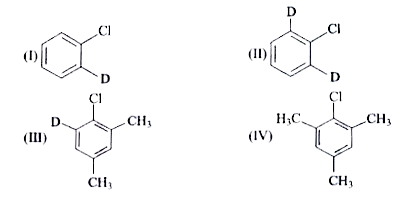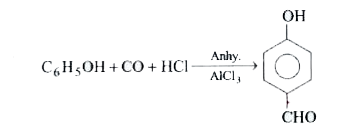Which of the following reaction belong to electrophilic aromatic substitution
Bromination of acetanilide
Coupling reaction of aryldiazonium salts
Diazotisation of aniline
Acylation of aniline
The correct Answer is:A, B
To determine which of the given reactions belong to electrophilic aromatic substitution, we will analyze each option step by step.
Step 1: Analyze Bromination of Acetanilide
- Reaction: Acetanilide (C6H5NHCOCH3) undergoes bromination.
- Mechanism: In this reaction, bromine (Br+) acts as an electrophile and attacks the aromatic ring of acetanilide. The amino group (NH2) in acetanilide is an ortho/para directing group, which means it will direct the bromine substitution to the ortho and para positions of the aromatic ring.
- Products: The major products are the ortho and para brominated acetanilide, with the para product being the major one.
- Conclusion: This reaction is an example of electrophilic aromatic substitution.
Step 2: Analyze Coupling Reaction of Aryl Diazonium Salts
- Reaction: Aryl diazonium salts react with phenol.
- Mechanism: The diazonium ion (Ar-N2+) acts as an electrophile and substitutes onto the aromatic ring of phenol, typically at the para position, forming an azo compound.
- Products: The product formed is para-hydroxy azo benzene, which is a dye.
- Conclusion: This reaction is also an example of electrophilic aromatic substitution.
Step 3: Analyze Diazotization of Aniline
- Reaction: Aniline (C6H5NH2) is treated with nitrous acid (HNO2).
- Mechanism: This reaction converts aniline into benzene diazonium chloride (C6H5N2+Cl-). However, no substitution occurs on the aromatic ring during this process.
- Products: The product is benzene diazonium chloride, and there is no substitution on the aromatic ring.
- Conclusion: This reaction is NOT an example of electrophilic aromatic substitution.
Step 4: Analyze Acylation of Aniline
- Reaction: Aniline is treated with acetic anhydride.
- Mechanism: In this reaction, the acylation occurs at the amine group, forming acetanilide (C6H5NHCOCH3). The aromatic ring does not undergo substitution.
- Products: The product is acetanilide, and again, there is no substitution on the aromatic ring.
- Conclusion: This reaction is NOT an example of electrophilic aromatic substitution.
Final Conclusion
Based on the analysis:
- Correct Answers: A (Bromination of Acetanilide) and B (Coupling reaction of aryl diazonium salts) are examples of electrophilic aromatic substitution.
- Incorrect Answers: C (Diazotization of aniline) and D (Acylation of aniline) are NOT examples of electrophilic aromatic substitution.
- Reaction: Acetanilide (C6H5NHCOCH3) undergoes bromination.
- Mechanism: In this reaction, bromine (Br+) acts as an electrophile and attacks the aromatic ring of acetanilide. The amino group (NH2) in acetanilide is an ortho/para directing group, which means it will direct the bromine substitution to the ortho and para positions of the aromatic ring.
- Products: The major products are the ortho and para brominated acetanilide, with the para product being the major one.
- Conclusion: This reaction is an example of electrophilic aromatic substitution.
- Reaction: Aryl diazonium salts react with phenol.
- Mechanism: The diazonium ion (Ar-N2+) acts as an electrophile and substitutes onto the aromatic ring of phenol, typically at the para position, forming an azo compound.
- Products: The product formed is para-hydroxy azo benzene, which is a dye.
- Conclusion: This reaction is also an example of electrophilic aromatic substitution.
- Reaction: Aniline (C6H5NH2) is treated with nitrous acid (HNO2).
- Mechanism: This reaction converts aniline into benzene diazonium chloride (C6H5N2+Cl-). However, no substitution occurs on the aromatic ring during this process.
- Products: The product is benzene diazonium chloride, and there is no substitution on the aromatic ring.
- Conclusion: This reaction is NOT an example of electrophilic aromatic substitution.
- Reaction: Aniline is treated with acetic anhydride.
- Mechanism: In this reaction, the acylation occurs at the amine group, forming acetanilide (C6H5NHCOCH3). The aromatic ring does not undergo substitution.
- Products: The product is acetanilide, and again, there is no substitution on the aromatic ring.
- Conclusion: This reaction is NOT an example of electrophilic aromatic substitution.
Based on the analysis:
- Correct Answers: A (Bromination of Acetanilide) and B (Coupling reaction of aryl diazonium salts) are examples of electrophilic aromatic substitution.
- Incorrect Answers: C (Diazotization of aniline) and D (Acylation of aniline) are NOT examples of electrophilic aromatic substitution.
Topper's Solved these Questions
- AMINESBOOK - NCERT EXEMPLAR ENGLISHCHAPTER - AMINESEXERCISE - SATQ
37 Videos
- AMINESBOOK - NCERT EXEMPLAR ENGLISHCHAPTER - AMINESEXERCISE - LONG ANSWER
3 Videos
- ALDEHYDE, KETONES AND CARBOXYLIC ACIDSBOOK - NCERT EXEMPLAR ENGLISHCHAPTER - ALDEHYDE, KETONES AND CARBOXYLIC ACIDSEXERCISE - Long Answer Type Questions
4 Videos
- BIOMOLECULES BOOK - NCERT EXEMPLAR ENGLISHCHAPTER - BIOMOLECULES EXERCISE - Long Answer Type Questions
5 Videos
Similar Questions
Knowledge Check
In which of the following compound electrophilic aromatic substitution take place in phenyl ring present in left hand side ?
A B
B C
C D
D
Which of the following will not undergo nucleophilic aromatic substitution ?
 AI, II and IIIBII and IVVCIII and IVDonly IV
AI, II and IIIBII and IVVCIII and IVDonly IVWhich of the following reactions is not an example of electrophilic substitution ?
AC6H6++NO2→C6H5NO2+H+BC6H5+CH3ClAlCl3−−→C6H5−CH3+HClCC6H6+Cl2UV light−−−−→C6H6Cl6DC6H5OH+CO+HClAnhy−−→AlCl3

Which of the following is most reactive towards electrophillic aromatic substitution for halogen ?
View SolutionWhich of the following is most reactive for electrophilic substitution reaction
View SolutionWhich of the following is the most reactive towards electrophilic substitution?
View SolutionWhich of the following reactions is not an example of electrophilic substitution in benzene ring?
View SolutionWhich one of the following undergoes nucleophilic aromatic substitution at the fastest rate ?
View Solution


